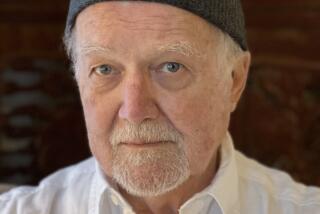Book review: ‘On the Black Hill’ by Bruce Chatwin
- Share via
On the Black Hill
A Novel
Bruce Chatwin
Penguin: 256 pp., $16 paper
Bruce Chatwin, the brilliant English writer and stylish nomad, died from AIDS-related complications in early 1989. His memorial service, held in a Greek Orthodox church in London on the day that Iran’s Ayatollah Khomeini issued a fatwa calling for the death of Chatwin’s friend Salman Rushdie, was a legendary event, mobbed by fans, celebrities and hundreds of journalists. Chatwin was by then a cult — admired as much for his self-mythologizing persona and the values of independent scholarship and the lonely questing that he seemed to represent as for his clipped, lapidary prose. With Chatwin, everything had to be the best: the writing, the conversation, the trip, the clothes, the Montblanc pens, the Asprey’s ink, the notebooks that were available only from a certain little Paris papeterie.
Since then, those Moleskine notebooks have become a global brand, while Chatwin’s reputation has dwindled. The irony might have amused him or prompted a Chatwinesque riff on how writers flourish and vanish but wait for history’s archaeologists to find them again.
One of Chatwin’s best books, “On the Black Hill,” has now been reissued with a gorgeous jacket by artist Daniel Albrigo. It tells the story of twin boys, Lewis and Benjamin Jones, who spend their entire lives on a small farm in the Black Mountains, a rural hinterland that straddles the border between England and Wales. The novel begins in the late 1800s and skips brightly through decades, while Lewis and Benjamin do the same job, sleep in the same bed, see the same land. World events and advancing technology inevitably impinge, but this is really a story about the mystery of time: how it changes people and how it doesn’t. Here Chatwin describes the moment preceding the twins’ birth:
“On the 8th of August the weather broke. Stacks of smoky, silver-lidded clouds piled up behind the hill. At six in the evening, Amos and Dai Morgan were scything the last of the oats. All the birds were silent in the stillness that precedes a storm. Thistledown floated upwards, and a shriek tore out across the valley. The labour pains had begun.”
This passage is typical. Chatwin slows down time, evoking the indelible atmosphere of a moment before dancing forward again. Entire chapters of “On the Black Hill” are sometimes devoted to a single day, while years hurtle by in the sub-clause of a sentence. The effect is mesmerizing.
At the still center of the book are Lewis and Benjamin, who literally share sensations. Their earliest memories are identical, and sometimes they dream the same dream. The relationship is telepathic, almost incestuous, and Benjamin, while apparently the less powerful of the two, manages to prevent Lewis from ever marrying. Lewis keeps a scrapbook of airplane disasters; Benjamin shrewdly acquires neighboring properties. Wars wash over them without disturbing their solitude: “Now and then, the drone of an enemy bomber, or some niggling wartime restriction, reminded them of the fighting beyond the Malvern Hills. But the Battle of Britain was too big for Lewis’s scrapbook.”
Eventually, the brothers cease talking to each other, symbiosis creating its own form of loneliness; but even death can’t part them, and the novel ends with Benjamin roosting on Lewis’ grave, staring at his own reflection in “a block of shiny black granite, one half with an inscription, the other left blank.”
During his life, Chatwin went into the remoter reaches of South America and the wilds of the Australian outback, real journeys that he transformed into explorations of his intellect and related in “In Patagonia” and “The Songlines.” Here, in “On the Black Hill,” he found the wonderful much closer to home. This novel is very much based, like all of Chatwin’s work, on research he did, places he went, people he met. Yet the book’s true source lies in the literary peaks to which this most driven and ambitious of writers aspired: Thomas Hardy, D.H. Lawrence, Flaubert, Hemingway, Osip Mandelstam. He aimed high and hit the target often enough. “On the Black Hill” can feel worked at, but it remains, more than 25 years after its first publication, beautiful and haunting.
Rayner writes about paperback reissues for Paperback Writers, which appears at https://www.latimes.com/books.
More to Read
Sign up for our Book Club newsletter
Get the latest news, events and more from the Los Angeles Times Book Club, and help us get L.A. reading and talking.
You may occasionally receive promotional content from the Los Angeles Times.








